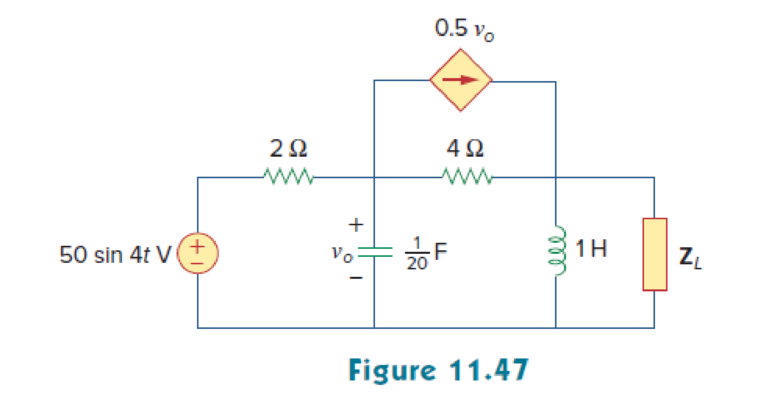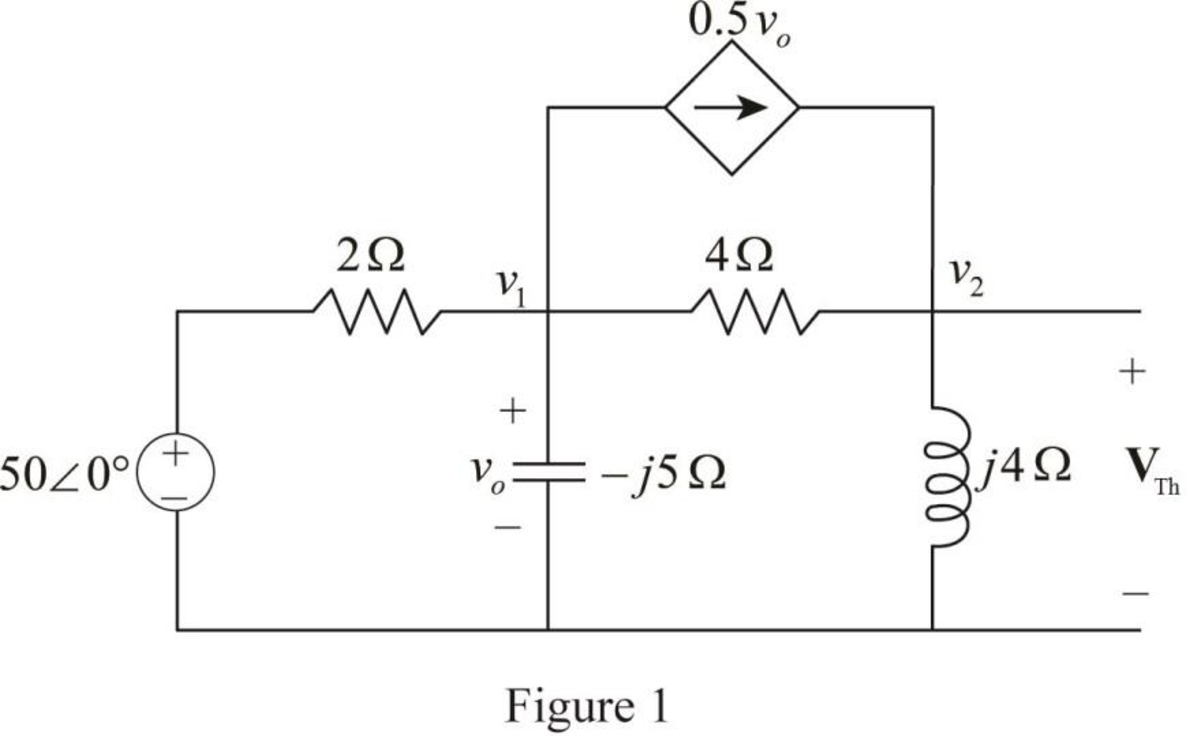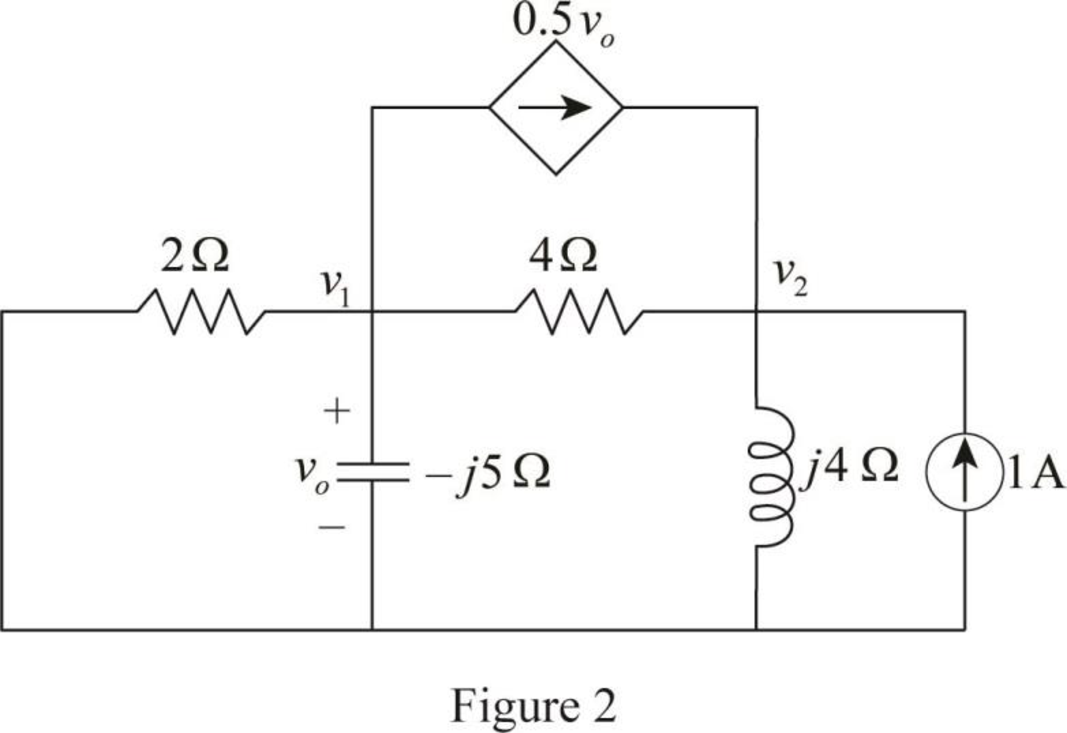
Concept explainers
For the circuit in Fig. 11.47, find the value of ZL that will receive the maximum power from the circuit. Then calculate the power delivered to the load ZL.

Find the value of the load impedance
Answer to Problem 16P
The value of load impedance
Explanation of Solution
Given data:
Refer to Figure 11.47 in the textbook.
The inductance
The capacitance C is
The source voltage is
Formula used:
Write the general expression for the instantaneous voltage.
Write the expression to find the maximum average power.
Here,
Write the expression for
Calculation:
On comparing equation (1) and (2), the angular frequency is,
Write the expression for the reactance of the inductance.
Substitute
Write the expression for the reactance of the capacitance.
Substitute
Refer to Figure 11.47 in the textbook.
To find the Thevenin equivalent the given Figure is modified as shown in Figure 1.

In Figure 1, apply Kirchhoff’s currrent law at node voltage
Rearrange the equation as follows,
In Figure 1, apply Kirchhoff’s currrent law at node voltage
Rearrange the equation as follows,
Substitute equation (6) in equation (5).
Rearrange the equation as follows,
The voltage voltage
Convert the equation from rectangular to polar form.
The Thevenin voltage is,
In Figure 1, to calculate the Thevenin impedance

In Figure 2, apply Kirchhoff’current law at node voltage
Rearrange the equation as follows,
In Figure 2, apply Kirchhoff’current law at node voltage
Rearrange the equation as follows,
Substitute equation (7) in equation (8).
Rearrange the equation as follows,
Convert the equation from rectangular to polar form.
The Thevenin impedance
Substitute
Convert the equation from polar to rectangular form.
For maximum average power transfer, the load impedance
Convert the equation from rectangular to polar form.
On comparing the equation (9) with equation (4).
Substitute
Conclusion:
Thus, the value of load impedance
Want to see more full solutions like this?
Chapter 11 Solutions
EE 98: Fundamentals of Electrical Circuits - With Connect Access
- QUESTION [3] A no-load and short-circuit test should be conducted on a 220V/110V, 280VA transformer. a. Draw the circuit diagram for the no-load test and include all measurements that should be made. Also write down the maximum voltage that you should apply to the primary winding and estimate the current drawn from the supply. (5) b. Draw a circuit diagram for the short-circuit test and include all measurements that should be made. Also write down the maximum current that should be allowed to flow in the primary winding and estimated the primary voltage that will cause this value of the current to flow. (5)arrow_forwardOnly expert should solve it pleasearrow_forwardNeed handwritten solution pleasearrow_forward
- Design a lowpass FIR filter using frequency sampling technique having cut-off frequency of T/2 rad/sample. The filter should have linear phase and length of 17.arrow_forwardA dc compound motor having a rating of 10 kW, 1150 r/min, 230 V, 50 A, has the following losses at full-load: bearing friction loss 40 W brush friction loss == 50 W windage loss = 200 W (1) total mechanical losses = 290 W (2) iron losses = 420 W (3) copper loss in the shunt field = 120 W copper losses at full-load: (4) a. in the armature b. in the series field c. in the commutating winding total copper loss in the 500 W 25 W 70 W armature circuit at full-load = 595 Warrow_forward4 What determines the power rating of a ma- chine? -5 If we cover up the vents in a motor, its out- put power must be reduced. Explain. -6 If a motor operates in a cold environment, may we load it above its rated power? Why?arrow_forward
- An electric motor driving a skip hoist with- draws 1.5 metric tons of minerals from a trench 20 m deep every 30 seconds. If the hoist has an overall efficiency of 94 percent, calculate the power output of the motor in horsepower and in kilowatts.arrow_forwardThe efficiency of a motor is always low when it operates at 10 percent of its nominal power rating. Explain.arrow_forwardA dc motor connected to a 240 V line pro- duces a mechanical output of 160 hp. Knowing that the losses are 12 kW, calculate the input power and the line current.arrow_forward
- A 115 V dc generator delivers 120 A to a load. If the generator has an efficiency of 81 percent, calculate the mechanical power needed to drive it [hp].arrow_forwardA machine having class B insulation attains a temperature of 208°C (by resistance) in a torrid ambient temperature of 180°C. a. What is the temperature rise? b. Is the machine running too hot and, if so, by how much?arrow_forward1 Name the losses in a dc motor. 2 What causes iron losses and how can they be reduced? -3 Explain why the temperature of a machine increases as the load increases.arrow_forward
 Introductory Circuit Analysis (13th Edition)Electrical EngineeringISBN:9780133923605Author:Robert L. BoylestadPublisher:PEARSON
Introductory Circuit Analysis (13th Edition)Electrical EngineeringISBN:9780133923605Author:Robert L. BoylestadPublisher:PEARSON Delmar's Standard Textbook Of ElectricityElectrical EngineeringISBN:9781337900348Author:Stephen L. HermanPublisher:Cengage Learning
Delmar's Standard Textbook Of ElectricityElectrical EngineeringISBN:9781337900348Author:Stephen L. HermanPublisher:Cengage Learning Programmable Logic ControllersElectrical EngineeringISBN:9780073373843Author:Frank D. PetruzellaPublisher:McGraw-Hill Education
Programmable Logic ControllersElectrical EngineeringISBN:9780073373843Author:Frank D. PetruzellaPublisher:McGraw-Hill Education Fundamentals of Electric CircuitsElectrical EngineeringISBN:9780078028229Author:Charles K Alexander, Matthew SadikuPublisher:McGraw-Hill Education
Fundamentals of Electric CircuitsElectrical EngineeringISBN:9780078028229Author:Charles K Alexander, Matthew SadikuPublisher:McGraw-Hill Education Electric Circuits. (11th Edition)Electrical EngineeringISBN:9780134746968Author:James W. Nilsson, Susan RiedelPublisher:PEARSON
Electric Circuits. (11th Edition)Electrical EngineeringISBN:9780134746968Author:James W. Nilsson, Susan RiedelPublisher:PEARSON Engineering ElectromagneticsElectrical EngineeringISBN:9780078028151Author:Hayt, William H. (william Hart), Jr, BUCK, John A.Publisher:Mcgraw-hill Education,
Engineering ElectromagneticsElectrical EngineeringISBN:9780078028151Author:Hayt, William H. (william Hart), Jr, BUCK, John A.Publisher:Mcgraw-hill Education,





